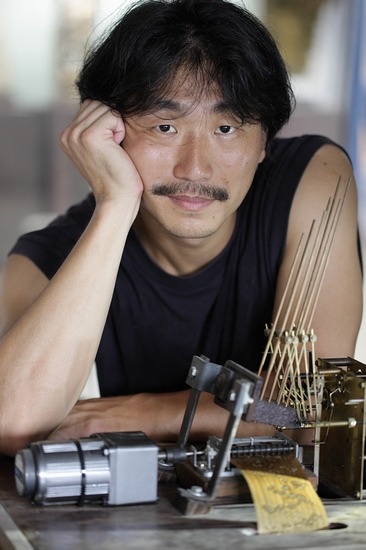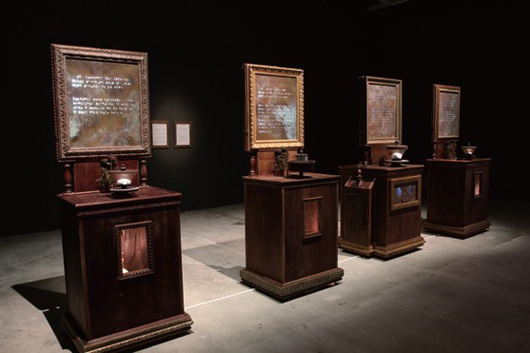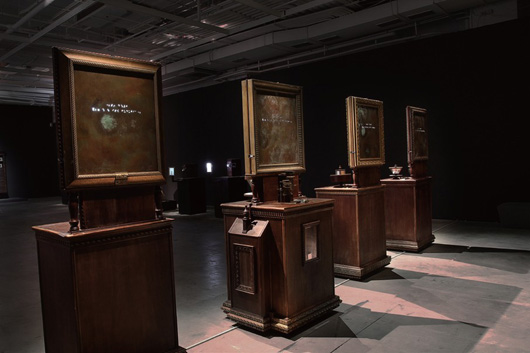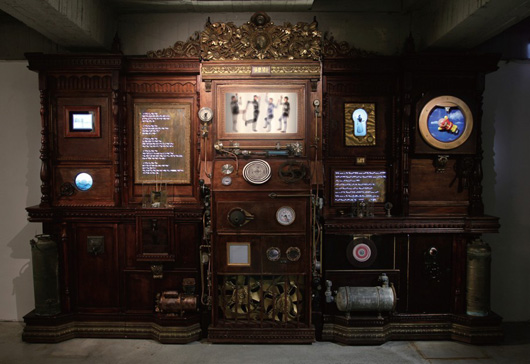|
Introduction of the artist:

TU Weizheng(China, Taiwan)
Selected solo exhibitions: 2012?Emperor`s Treasure Chest of the City,
TKG+ Gallery, Taipei; 2003?The Beauty and Mystery of Bu Num Civilization
Revealed, MOCA, Taipei; 2003 Exhibition of Excavation Work at the Bu Num
Civilization Site, TNCA, Tainan;
Selected group exhibitions: 2012 9th Gwangju
Biennale, South Korea; 2012 Roundtable, Gwangju Biennale Foundation
Korea;
2012?Time Games: Contemporary Appropriations of the Past, Taipei Fine Arts
Museum, Taipei, Taiwan; 2011 Nostalgia, East Asia Contemporary Art Exhibition,
Korea Foundation Cultural Center, Seoul, Korea; 2010?By Day, By Night,?or Some
Special Things a Museum Can Do, Rockbund Art Museum, Shanghai; 2010 Taiwan
Biennial; 2008? Reason's Clue, Queens Museum of Art, New York; 2006?the 6th
Shanghai Biennale, China.
Tu Weizheng’s Optical Trick is an on-going series of installations that not
only seek to play mechanical and photographic ‘tricks’ but also, and moreso,
seek to re-interpret the spirit of contemporary urban lives. To create Happy
Birthday, his new installation in Guangzhou, Tu invited four blind children to
make wishes for their upcoming birthdays, assisted by the Guangdong Museum of
Art’s educational team, along with local volunteers.In response to their wishes,
the artist constructed the installation’s components, referencing the contours
of what looks like it could have been a grandfather clock, an antique cabinet or
a dressing table set with a bronze-plated mirror. The words of the children’s
birthday wishes are represented in braille, some engraved on copper sheets and
framed by light-boxes, projecting the words like a glittering array of stars,
others punctured on metal strips and fed into music boxes, transformed into
musical notes. The four parts of the installation are placed around a central
skylight, each facing a different direction, as if calling out in a state of
anticipation, of longing. On each table, there is a praxinoscope, a simple
animation device by which, through the twelve-mirror inner circle of its
cylinder, the artist’s drawings of the children can be seen spinning round in a
blithe dance. A clock’s pendulum swings without rest, waiting for the hand to
strike and the bell to sound, marking the moment when dreams come true.What is
the colour of their unseen world? It must be even more hopeful than this visible
one. Don’t believe it?
Listen, carefully. !
Introduction of works:


Happy Birthday, installation, 2012

The Emperor’s Treasure Chestes-one, installation, dimensions variable,
2012
Tu Weizheng’s Optical Trick is an on-going series of installations that
present mechanical and photographic ‘tricks’ and also seek to re-interpret the
spirit of contemporary urban lives. The starting point of his new installation
in Guangzhou, Happy Birthday, invited four blind children to make wishes for
their forthcoming birthdays, with assistance provided by the educational team of
the Guangdong Museum of Art and local volunteers.
In response to the wishes, the artist constructed the installation
referencing the look of a grandfather clock, an antique cabinet or a dressing
table set with a bronze mirror. The children’s birthday wishes are represented
in Braille, some engraved on copper sheets and elaborately framed as light-boxes
to map out a glittering array of stars, and others punctured on metal strips as
part of the mechanisms of a music boxes that are then transformed into various
musical notes. The four parts of the installation are placed around a central
skylight facing different directions, waiting and longing. On each table, there
is a praxinoscope, a simple animation device where, through the inner circle of
twelve mirrors in its cylinder, the artist’s drawings of the children can be
viewed spinning into a blithe dance. A clock’s pendulum swings non-stop, whilst
waiting for the moment of ringing to mark when dreams come true.
What is the colour of their unseen world? Here, it must be more hopeful than
the visible one. Don’t you believe this? Listen, carefully. | 
